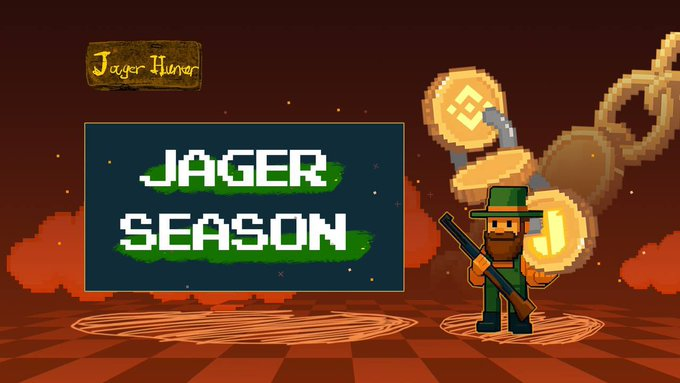Background and Community Narrative of JAGER Token Launch
Recently, Binance Alpha announced the listing of the BNB Chain community Meme token Jager Hunter (JAGER), attracting widespread market attention. JAGER Token is named after Binance’s early Telegram community manager Jager, and its core narrative revolves around the concept of “the smallest unit of BNB” (1 BNB = 100,000,000 JAGER), aiming to strengthen community cohesion through cultural symbols. The project team emphasizes its goal to create a “community consensus token of the BNB Chain ecosystem” rather than a technologically innovative asset. This strategy quickly attracted speculative funds, with the token surging 166.63% within 24 hours of launch, peaking at 0.00004432 before falling back to around 0.000034 due to market sell pressure.

Spot trading opened at 18:00 (Beijing time) with the JAGER/USDT trading pair, followed half an hour later by the launch of perpetual contracts with up to 50x leverage. The concurrent airdrop campaign covered BNB Chain, Solana, and Ethereum users, with 3% of the total supply distributed via a decay mechanism—each claim reduces the remaining airdrop base by 2.5%, and subsequent user allocations shrink by 20%. This design spurred early participants to rush in, attracting over 110,000 addresses in three days, but also resulted in high token concentration among top holders (Top 10 wallets hold 92.42%), raising liquidity risk concerns.
Token Economic Model and Market Operation Mechanism
The total supply of JAGER is fixed at 14.6 trillion tokens, with a fully diluted market cap of approximately $388 million. Its distribution follows a typical Meme coin model: 90.5% distributed through a fair airdrop, 3% allocated to ecosystem funds for incentivizing partners, and the remaining 6.5% assigned to the team and exchange liquidity pools. Although the project claims “zero presale, zero team reserve,” on-chain data shows over 40% of the tokens flowed to related wallet addresses, triggering community concerns over hidden control.
In terms of trading mechanism, JAGER Token adopts a 10% transaction tax model: 4% redistributed to holders as dividends, 3% injected into the liquidity pool, and 3% allocated to team operations. While theoretically forming a token economic cycle, in practice, the high tax increases trading friction in the secondary market. For example, if a user buys JAGER for 100, they actually receive only 90, requiring the price to rise at least 11.1% to break even. Additionally, the token’s liquidity heavily relies on decentralized exchanges. As of May 6, the JAGER/WBNB pool on PancakeSwap accounts for 76%, with centralized liquidity exacerbating price volatility risk.
Market Volatility Logic and Potential Risks
JAGER’s price movements highlight the speculative nature of Meme coins. In its early stage, market sentiment driven by the “BNB ecosystem narrative” and airdrop expectations led to rapid price increases. However, the price corrected due to three factors:
-
Airdrop participants sold en masse to realize gains,
-
The transaction tax suppressed short-term speculation,
-
Regulatory risks raised concerns—on May 6, Korea’s Financial Supervisory Service issued a warning to increase scrutiny on “tokens without real use cases.”
Key potential risks to monitor include:
-
High Concentration of Holdings: The top 10 addresses control 92.42% of the tokens, posing a risk of coordinated dumps.
-
Feasibility of Multi-Chain Expansion: While the project claims plans to expand to Solana and Ethereum, no technical roadmap has been disclosed.
-
Regulatory Policy Shocks: The EU’s MiCA legislation, effective December 2025, may restrict high-volatility Meme tokens from listing on compliant exchanges.
Notably, some exchanges have implemented risk controls. For instance, Ourbit limited the maximum leverage for JAGER Token perpetual contracts to 20x, more conservative than Binance Alpha’s 50x. Investors should be cautious of liquidation risks under high leverage and may consult JuCoin’s derivatives risk guide for strategy planning.
Long-Term Value Assessment and Ecosystem Development Path
For mid- to long-term investors, it’s recommended to monitor the following indicators:
- Growth rate of token-holding addresses: A weekly increase below 1,000 may indicate waning interest.
- Transaction tax consumption ratio: If daily tax allocations fall below the team’s operational budget, sustainability may be at risk.
- Cross-chain progress: The launch time and liquidity depth of JAGER on Solana will determine its ability to break ecosystem constraints.
Although JAGER currently lacks technical backing, its development potential is deeply tied to the BNB Chain ecosystem. If the team delivers on two promises, it may gain a competitive edge: Implementing DAO governance to convert token holders into co-builders of the ecosystem. Collaborating with platforms like Four.meme to develop SocialFi scenarios (e.g., meme NFT minting, community task incentives).
Historically, BNB Chain projects like CAKE and BabyDoge achieved value retention through “utility + community operation,” which may serve as JAGER’s future roadmap.





